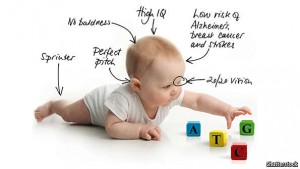A. T. C. G. These four letters, put into a specific order, help determine who we are–our physical traits, personality, intelligence, risk for certain diseases later in life, and much more. And scientists have put their heads together and developed a simple, quick way to edit this order. It is designed to remove unwanted genes (perhaps a gene that is linked to a genetic disorder) and “paste” other As, Ts, Cs, and Gs.
CRISPR, as the technology is called, consists of RNA and a nuclease. The RNA acts as a guide, pinpointing the location of the DNA that needs to be removed. The nuclease cuts the DNA and then a new genetic information is put in its place. (“The age of the red pen.”) The technology holds promise in various areas within medicine “from Alzheimer’s to cancer to HIV.” (“Editing Humanity”)
As an article from The Economist notes, “By allowing doctors to put just the right cancer-hunting genes into a patient’s immune system, the technology
could lead to new approaches to oncology. It may also accelerate the progress of gene therapy—where doctors put normal genes into the cells of people who suffer from genetic diseases such as Tay Sachs or cystic fibrosis.” (“Editing Humanity”)
Although CRISPR has many positive attributes, it is worth noting that the technology is controversial with regards to its ethical implications. Countries, in the future, will need to discuss legal boundaries to determine when it is ethical or unethical to use CRISPR.
 For more information about this fascinating technology, please visit: http://www.economist.com/
For more information about this fascinating technology, please visit: http://www.economist.com/
For more insight into the ethical implications of CRISPR, see: http://www.washingtonexaminer.com/
